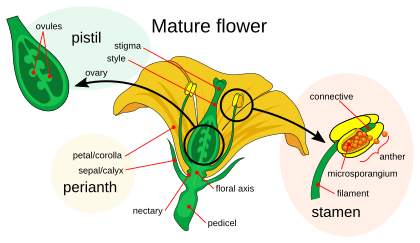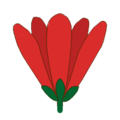Petal facts for kids
A petal is a colorful part of a flower. Petals often have bright colors and a nice smell. They help attract insects and birds to the flower. This attraction is important for pollination, which helps the flower make seeds. Petals are mostly made of cellulose, a natural material found in plants.
Petals are like special leaves that have changed over time. They grow around the parts of the flower that help it reproduce. All the petals of a single flower together are called a corolla.
The way petals look and how flowers have changed over many years is a big part of studying plants, called botany. Scientists have been learning about this since the 1700s!
Contents
How Petals Help Flowers
The main job of petals is to help with pollination. Pollination is how pollen moves from one flower to another, allowing plants to make seeds and new plants. Petals use their colors, shapes, and scents to attract different helpers for this job.
Different Ways Flowers Get Pollinated
Flowers have many clever ways to get pollinated. Here are some common types:
Wind Pollination
Some flowers don't need bright petals or strong smells. These flowers are often small and dull. They might not even have petals at all! They produce a lot of pollen that the wind easily carries away. Think of grasses or many trees; their flowers are often pollinated by the wind.
Insect Pollination
Flowers that rely on insects are often very showy. They might have bright colors that insects can see, even in ultraviolet light, which humans can't see. Many also have special lines on their petals called "honey guides." These guides act like landing strips, leading insects right to the nectar, a sweet liquid the flower produces. A strong scent is also common to attract insects from far away.
Bird Pollination
Flowers pollinated by birds are usually large and very colorful. Birds have good eyesight and are attracted to bright reds, oranges, and yellows. These flowers also produce lots of nectar to give the birds energy. As the birds drink the nectar, pollen sticks to their beaks or feathers and gets carried to the next flower.
Images for kids
-
Tubular-campanulate corolla, bearing long points and emergent from tubular calyx ( Brugmansia aurea, Golden Angel's Trumpet, family Solanaceae ).
-
The white flower of Pisum sativum, the Garden Pea: an example of a zygomorphic flower.
-
Narcissus pseudonarcissus, the Wild Daffodil, showing ( from bend to tip of flower ) spathe, floral cup, tepals, corona
See also
 In Spanish: Pétalo para niños
In Spanish: Pétalo para niños








